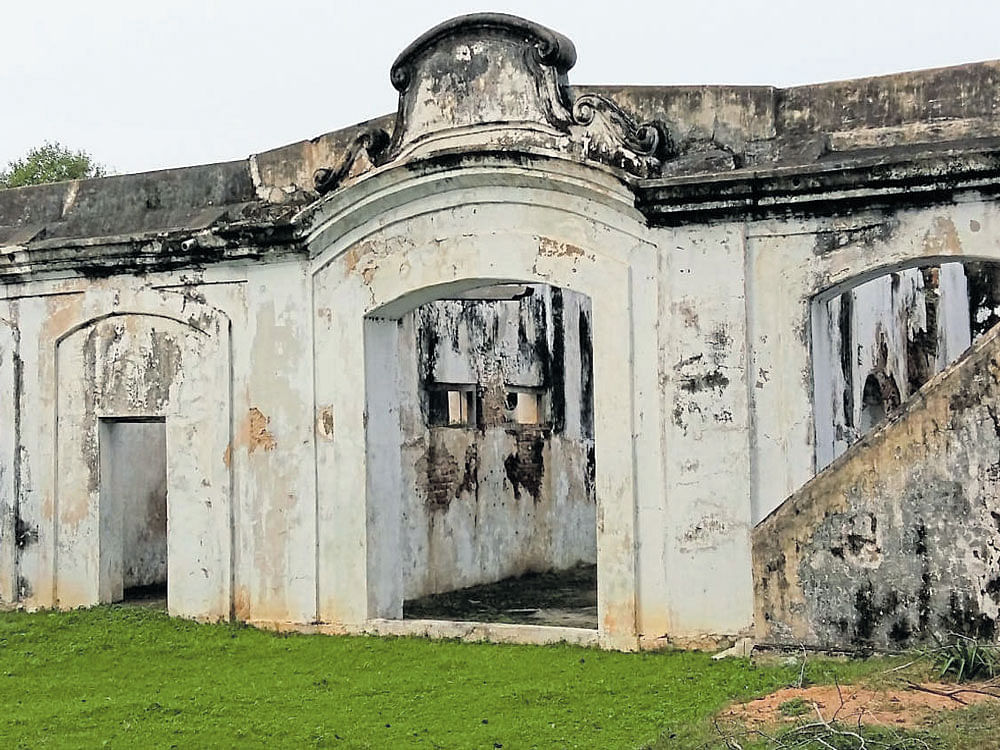
Historical monuments at Bandar Fort, which was once the east coastal gateway of trade for the Dutch, French, British and the Nizam rulers, are now in utter neglect.
The grand entrance of the fort, store houses, armoury, jail and the historical memorial built in memory of 30,000 lives lost during the 1864 cyclone are in a state of dilapidation.
Just six kilometres from Machilipatnam, the district headquarters of Krishna District, is the Bandar Fort where a few structures built by the Dutch rulers withstood several major and minor cyclones to tell the story of the early struggles of foreign rulers. It is said that traders from foreign countries enjoyed great level of freedom in the coastal town, also known as Bandar.
According to Captain Albert Harvey of the British army, during his 10 years of stay in India, the fort, which was built by the Dutch, had an arsenal store meant for supply of ration to troops in Hyderabad and Nagpur subsidiary forces as well as the whole of the northern division of the British army.
“It contained necessaries of every description and they were kept, in first rate order by the commissariat and there were many warrant officers attached to the establishment. The curious old records kept in it gave an idea of how things were managed in those times. The old hospital which is now roofless is said to belong to the Nizam,” the captain in his testimony in “The Dutch Remains in Machilipatnam” said.
The armoury which was used as customs and port office consists of a quadrangular enclosure, with rooms and godowns built around it. The enclosure is divided into two open courts by a narrow block of buildings in the centre.
In 1622, English factories from Bantam, UK, succeeded in establishing trade with Machilipatnam. In 1628, the British were driven out by the oppression of native governments, but after five years the British returned by establishing a factory, through a “farman” of the Golconda rulers. However, the factories of the British were seized by the Mughals in 1689 through another “farman” by a Mughal General located in Deccan but the British were allowed to settle in Machilipatnam within the territories of Golconda rule.
For some time between 1759 and 1765 the Fort was under the French rule, as a part of the northern “sarkars”, and annexed to East India Company. The Dutch built the fort at Machilipatnam but greater parts of the ramparts were entirely levelled. The fort was redesigned by Sir Charles Trevelyan who wanted to level the walls, and lay out boulevards and a people’s park. But that idea was dropped following the 1864 cyclone.
According to a local historian Mohammad Silar, the Dutch who were called as “Vallandulu” in local slang arrived in Machilipatnam in 12 ships somewhere in 1602 and stayed up to 1697.
“They took permission from the Quli Qutubshahis in 1605 and built a textile factory at Bandar Kota. The Qulis had permitted trade at a tax of 4%,” Silar says. The factory added to the attraction of Bandar Fort to many other foreign traders, including the British. However, Silar says that unlike the Portuguese and the British, the Dutch restricted themselves to trade and did not show any inclination to rule the locals.
Dutch developed ship-building industry near Odapalem (now Vadapalem) at Pedayadara, five km from Machilipatnam town to help export and import of material from the port . “The Dutch benefitted a great deal from the lightweight wood available on the banks of Krishna River near Divi seema,” Silar says.
The Dutch also engaged local artisans to make Kalamkari dress material by offering the artisans all the necessary inputs. The shed-wise production system introduced by the Dutch can still be seen in Pedana, known for its Kalamkari dress-making.
The Dutch who made an early entry into Machilipatnam, compared to the British, required protection for their operations and the material waiting for export from the Bandar Port. They built 12 outer walls around the godown constructed by the Golconda Sultans over hillock surrounded by water. In later years the Dutch also built an armoury and a cemetery. The Dutch built a strong walled store house to store gun powder very next to the Bandar Fort.
Another monument that is facing utmost neglect is the Cyclone memorial slightly away from the fort, close to the village of Bandar Kota. The structure built by the then British collector Thorn Hill, is in memory of 30,000 people who died on the fateful day of November 1, 1864, incidentally All Saints Day. More than 13 feet high tidal waves engulfed the town up to 17 km in radius. In that cyclone half of the town’s population was washed away. The Dutch built structures which were occupied by the British that survived the deluge, but several British officers and their family members died in that cyclone.
Legend says that Manuel Truvalll, brother of one Anthony Farwall, built a memorial in Bandar Fort area in the memory of the entire family of Anthony Truvall, his wife Maria, sons Michael, Peter, Manuel, Daniel and daughter Mary Honey and her children Joseph and Georgiana, who died in the cyclone.
“The memorial was actually built on the remains of the house in which that family lived. However, the engraving on the memorial also remembers all the 30,000 souls that joined the almighty God that day,” says Rajani Kanth, a local resident.
ASI’s representatives protecting these structures said they will soon take up renovation of the Dutch Armoury after a detailed study on the existing structural status of the historical building.
“The collapsed portion will soon be renovated in order to conserve the structure that speaks volumes about the marine trade operations in Machilipatnam during the period of the Dutch and the British,” ASI Superintendent Archaeologist Kannababu said.